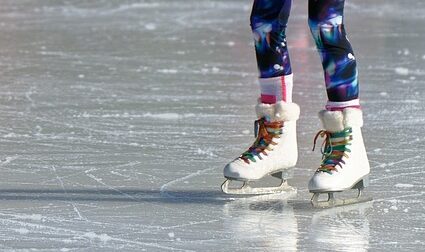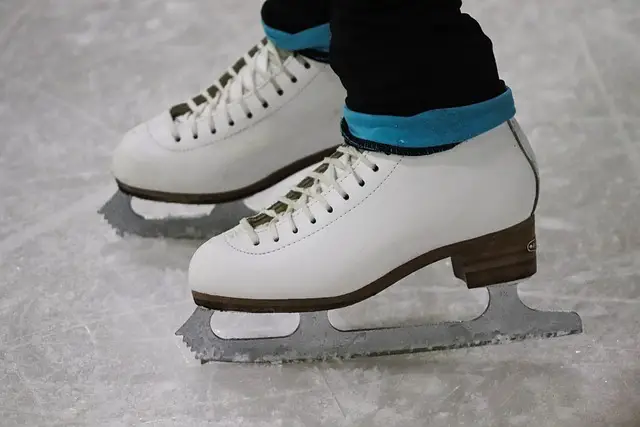Recreational ice skates are designed for general ice skating purposes and are typically more comfortable and forgiving. They have a traditional blade profile and are suitable for casual skating. On the other hand, figure skates are specifically designed for figure skating and offer more ankle support and a longer, more curved blade to assist with jumps, spins, and intricate footwork on the ice.
Recreational ice skates

(Image by Silviu on the street from Pixabay)
Recreational ice skates are a great choice for beginners or casual skaters who want to enjoy the simple pleasures of gliding around on the ice. They’re typically more affordable than figure skates and offer a comfortable, relaxed fit that’s perfect for spending an afternoon at the rink with friends.
One of the key differences between recreational and figure skates is their blade design. Recreational skates have straight blades that provide stability and control, making them easier to balance on compared to curved blades found on figure skates.
Another difference is in their toe picks. Recreational ice skates don’t have prominent toe picks like those found on figure skates, which can make stops and turns more difficult but also prevent tripping hazards.
Recreational ice skates are ideal for anyone looking to simply have fun on the ice without worrying about mastering complex techniques or movements. They may not be as flashy or precise as figure skates, but they certainly get the job done when it comes to enjoying time spent skating!
Figure skates

(Image by Manfred Richter from Pixabay)
Figure skates are specialized ice skates that are designed for competitive figure skating. They differ from recreational ice skates in many ways, including blade design, toe picks, and techniques used on the ice.
The blades of figure skates have a longer and flatter profile compared to those of recreational ice skates. This allows for more stability and control during complex spins and jumps. The toe picks on the front of the blade are also larger and sharper than those found on recreational ice skates, allowing for greater precision when executing intricate footwork.
Techniques used in figure skating include jumps such as axels, flips, and lutzes; spins such as camel spins or sit spins; and footwork sequences involving turns, steps, spirals and other intricate movements. These require a high level of skill which is developed through years of practice.
Figure skating has been an Olympic sport since 1908 with individual men’s singles being its first event. In modern times it has become one of the most popular winter sports globally with millions taking part every year at various levels.
Figure Skating is an incredibly demanding but rewarding sport that requires hours upon hours of dedicated training to perfect your skills. Many people enjoy watching professional competitions to marvel at the awe-inspiring routines put together by these highly skilled athletes who make it look effortless while performing death-defying moves on razor-sharp blades!
Recreational ice skates Vs. Figure skates – Key differences
When it comes to ice skating, there are two common types of skates: recreational and figure. While both have blades and allow you to glide on the ice, they have significant differences that make them unique.
The most apparent difference between these two types of skates is their design. Recreational ice skates feature shorter blades that help individuals move easily in all directions with less effort. On the other hand, figure skates come with longer blades designed for precise movements such as spins and jumps.
Another key difference lies in their toe picks – small serrated teeth at the front end of the blade. Figure skaters use toe picks to gain momentum or stop abruptly during a performance, while recreational skaters don’t need this additional support.
Techniques used by recreational and figure skating also vary significantly. Recreational skating involves more casual gliding on open ice without any specific movement requirements or routines, whereas figure skating requires technical skills that involve performing intricate moves like spins, jumps or choreographed routines.
Whether you opt for recreational skate or figure skate depends solely on your level of experience and purpose for using them-whether just for fun or professional purposes.
Blade designs
When it comes to ice skates, one of the key differences between recreational and figure skates is the design of their blades. Recreational ice skates typically have a straighter blade that offers stability for general skating activities. On the other hand, figure skates feature a curved blade that allows for greater maneuverability and control during complex routines.
The shape of these two types of blades reflects their intended use. For example, recreational ice skaters will generally be moving in relatively straight lines or gentle curves, while figure skaters need to execute sharp turns and jumps with precision.
Additionally, the toe picks on each type of skate are also different in size and shape. Figure skate toe picks are usually larger than those found on recreational ice skates as they play an important role in executing jumps and spins.
Understanding the differences between blade designs can help you choose the right type of skate for your individual needs whether it’s just having fun at your local rink or preparing to compete professionally.
Toe picks
When it comes to differentiating recreational ice skates from figure skates, one of the key aspects to consider is the toe picks. These are teeth-like protrusions located at the front of a figure skate’s blade that help with jumping and spinning.
The size and shape of toe picks can vary depending on the level and discipline of skating. Figure skaters who perform jumps and spins require larger, more prominent toe picks for stability and power during takeoff. Meanwhile, recreational ice skaters typically have smaller or non-existent toe picks since they do not need them for their activities.
It’s also important to note that while toe picks may seem like an added advantage for figure skating, they can be challenging to master. Skaters must learn how to use them effectively without tripping or losing balance on the ice.
Understanding the difference in toe pick designs between recreational ice skates and figure skates can help you choose which type is best suited for your needs as a skater.
Techniques
When it comes to ice skating, the techniques used can vary greatly between recreational and figure skating. Recreational skaters typically focus on basic movements such as gliding forward, backward, and turning. They may also learn how to stop or skate backwards in a straight line.
Figure skaters, on the other hand, require more advanced techniques that involve jumps, spins, and intricate footwork. These athletes spend countless hours perfecting their skills in order to compete at the highest level.
One of the key differences in technique between recreational and figure skating is body positioning. Figure skaters must maintain proper posture throughout their routines in order to execute difficult moves with precision. This includes keeping their arms extended and maintaining a strong core.
Another important technique for figure skaters is edge work. Skaters must be able to balance on one blade while still being able to move fluidly across the ice. This requires not only physical strength but also mental focus and concentration.
Whether you are a recreational or competitive ice skater, mastering proper techniques is essential for success on the ice. With practice and dedication, anyone can improve their skills and enjoy all that this beautiful sport has to offer!
Pros and Cons of Recreational ice skates
Recreational ice skates are designed for individuals who skate occasionally. They are perfect for leisure skating, outdoor skating, and even just a fun time with family and friends. One of the major advantages of recreational ice skates is their affordability. They come in various sizes and styles to suit different preferences.
One downside of recreational ice skates is that they may not provide enough support for someone who wants to do more than casual skating. Since they don’t have toe picks like figure skates, it can be challenging to perform jumps or spins on them.
Another advantage is that they’re usually very comfortable to wear due to their soft boots which makes them great for beginners or people looking for a relaxed experience on the rink.
On the other hand, if you intend to use your recreational ice skates frequently or progress beyond basic skills, durability becomes an issue as they often start falling apart after few uses – especially when used regularly on rough surfaces such as outdoor ponds.
Whether recreational ice skates are suitable depends on one’s purpose and skill level. While there may be some limitations regarding advanced moves or longer-term use; these types of iceskate offer comfortability at budget-friendly prices making them suitable options especially during winter vacations!
Pros and Cons of Recreational Figure skates
When it comes to recreational figure skates, there are some clear pros and cons that skaters should consider before making a purchase.
One of the biggest advantages of recreational figure skates is their versatility. They are designed for a wide range of skill levels and can be used for both casual skating and more serious figure skating techniques. This makes them ideal for beginners who want to get started with basic moves but also have room to grow as they improve.
Another benefit is their comfort level. Recreational figure skates typically have softer boots than traditional figure skates, which means they offer greater flexibility and support for your feet. This can make them much more comfortable during longer periods on the ice.
However, there are some downsides to these types of skates as well. For one thing, they may not provide enough support or stability for advanced jumps or spins. If you’re looking to take your skills to the next level in competition or performance settings, you’ll likely need specialized equipment.
Additionally, recreational figure skates may not last as long as traditional ones due to their softer materials – so if you plan on using them frequently over a long period of time, you may need to replace them more often.
Whether or not recreational figure skates are right for you will depend on your specific needs and goals as a skater. Consider factors like comfort level, skill level, durability requirements and budget when making your decision!









